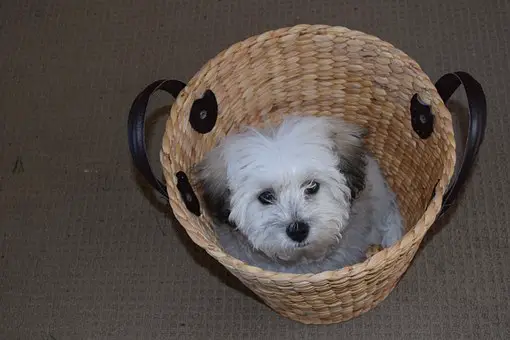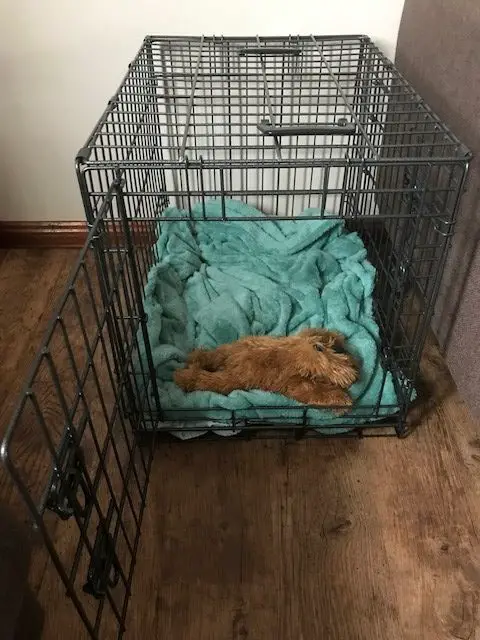Crate Training A Maltese Puppy : Instructions
Crate training is where you are placing your Maltese dog into a crate for a period of time. The training method explained within this article will help the training go smoothly for both your Maltese puppy and you. It can be a very emotional experience as your Maltese puppy may cry at times while in the crate.
Crate training your Maltese dog is an activity that is emotional and daunting to first time pet owners. It requires a significant commitment to the training but with the right amount of patience and dedication it is something that can be achieved. Having a Maltese puppy that is crate trained is so beneficial and can be such a useful tool long term to you as a Maltese pet owner.
Positives of Crate Training a Maltese Puppy
There are many positives in Maltese dog crate training. These include:
- New puppies benefit greatly from crate training as it gives them their own personal space and is a place where they can feel safe and secure.
- It is also good to be able to contain or limit them access to the rest of the house when you need to attend to something else and cannot supervise them.
- It is also a good time out place when new Maltese puppies are testing their boundaries or do not like the rules.
- It can be very beneficial in toilet training as dogs do not like to go to the toilet where they sleep so they quickly learn not to go to the bathroom in their crate.
- Crates can also be very useful when transporting your Maltese dog. Because the crate is somewhere that they already feel secure it is not such a big transition to go into it when it is time to travel by car. It is also comforting to the dog and may make travelling that much easier for you and your Maltese puppy.
If you use your crate in the correct way it is such an effective learning tool and will quickly be considered a safe and comforting spot to your dog.

How to select a crate for your Maltese Dog
There are many different crates on the market made in different sizes and from different materials. It can be overwhelming as crates come in canvas, plastic and metal and in many different sizes. So which one is the best for your Maltese dog?
What should the crate be made out of?
It is recommended to get a metal crate for your Maltese dog. Metal crates are sturdy, easy to clean and are usually collapsible for ease of relocating them or if you are travelling with them. You can find metal crates at most pet stores or online.
What size Crate should you get for a Maltese Puppy?
A good rule for sizing of a crate is that you want it to be big enough for your Maltese dog to be able to stand up and turn around as a mature full grown dog. If you get a crate smaller than this you will have to upgrade as the dog gets larger. One of the neat little devices available in metal crates is that they usually come with a removable divider so that you can make the crate smaller when your Maltese is a puppy then you can take out the divider as they grow. This allows your crate to work for both a small puppy and a fully grown adult Maltese dog.
The Crate Training Process for a Maltese Dog
The process of crate training a Maltese dog can be time consuming. Depending on the age of your Maltese dog and their temperament it can take anywhere from days to weeks. There are two important things to keep in mind when crate training a Maltese puppy. These things are that the crate should be a pleasant space for the dog and that training should be undertaken at a slow speed as to not overwhelm your Maltese dog. A smaller Maltese puppy may take to the crate a lot quicker than a stubborn older Maltese dog. This is why it is important to start crate training as early as possible so that the crate is seen as normal. Older Maltese dogs may become stressed and take longer before they feel the crate is a secure safe place. Separation anxiety could make the experience worse so if your dog does have separation anxiety just take your time and be forgiving of their cry’s
There are three distinct steps when trying to train a Maltese dog to use a crate. These steps include:
- The introduction of the crate to the Maltese Dog
- Extending the time period your Maltese dog in is the crate
- Crating your Maltese while you are not around
- Crating your Maltese during the night
Step 1 – Introducing the crate
It is always a good idea to put the crate for your Maltese puppy in an area of your home that is frequented by your family. A good suggestion is the lounge room or living space as this ensures that your Maltese dog is not alone and feels comfortable especially in the early training.
Prepare the crate so it is comfortable and appealing to the dog. A good example would be to put in a small toy and to prepare the crate with towels and blankets. The next step is to bring your dog over to the crate and speak in a happy tone and make sure that the crate is already opened and prepared for your dog. Encourage your dog to enter the crate, this is where food is a good motivator. Place some treats in the crate just inside of the door way and increase the depth of the food inside the crate until your Maltese dog is going all the way into the crate. Be careful to not force your dog into the crate as this could scare them. Just keep putting the treat inside and encouraging your Maltese dog until they go all the way into the crate on their own. This may take some time. It could be as little as a few hours to as long as a few days. Be patient and if your Maltese puppy is not interested in the treats you can try the same process but replace the treats with something they are interested in like a favourite toy. If dog treats do not work then use their favourite food as this will usually entice them into the crate.
Once your dog has been introduced to the crate and feels comfortable going in it for treats you should start to feed your Maltese dog all its meals in the crate. This creates a good association with the crate. If your Maltese dog will go all the way in the crate, then start to put the food dish to the back of the crate, if they are still reluctant to go to the back of the crate then put it as far as your Maltese dog is comfortable going. Move the bowl further back each time you feed your Maltese dog till the dish is at the back of the crate.
Once your dog is happy to go into the crate to eat its meal start to close the crate door while your dog eats. To begin with, as soon as the dog has finished eating, open the door and let your Maltese puppy out. Each time you feed your Maltese puppy increase the time you take to open the door so that the dog gets used to being in the crate with the door closed. Your goal of doing this step is to be able to leave the time the dog is in the crate after meals up to the 10 minute mark. This helps to condition your Maltese dog to feel safe in the crate even when you are not around.
If your Maltese cries to be let out then you may have progressed too quickly with the length of time you are leaving them in there. Try a shorter period on the next few attempts. Even if you dog is crying you will need them to stop crying before you let them out. Try telling them to sit so that you get their attention off getting out of the crate by crying. When they do sit you can open the crate and let them out. This reinforces that if they sit and wait you will let them out rather than them crying to be let out of the crate.

Step 2: Extending the time period your Maltese dog in is the crate
One you have successfully taught your Maltese to eat their meals in the crate the next step is to get them to use the crate even when they are not eating. To do this you should start with short periods when you are home. Using treats are always a positive way to reward good behaviour and to get your Maltese puppy to do what you want. To start with call your dog to the crate and place them inside. Feed them the treat and say a training word such as “crate”. Open the door and repeat the exercise a few times so that the Maltese puppy understands that if they are in the crate you will praise them. next leave the door open and say the training word “crate”. If your Maltese puppy jumps into the crate then you should reward them with the treat and praise them for obeying your command. If they do not get into the crate use the training word again and place them in the crate and then give them the treat. You are trying to associate praise and food with the training word “crate” and the action of getting into the crate. Keep up this training method till your dog learns the command. This could take minutes, hours or even days to get right. The more training you do with your Maltese puppy the quicker they will be able to learn the command. Some puppies are more stubborn then others and may resist. Just keep at it and keep it consistent.
Once you have trained your Maltese puppy to get into the crate it is time to extend the time they sit in there without you around. Ask your Maltese puppy to get into the crate and give them a treat. Leave the room for a few minutes. After a few minutes return to the room but do not open the crate straight away. Give them a minute and then ask them to sit before you open the gate. Normally they will be very excited for you returning to the room so expect your Maltese puppy to be jumping and crying but ensure they settle down and sit before you open the crate. Repeat this process a few times a day and extend the time frame longer. Each repetition should be as long or longer than the previous attempt. The aim is to increase this time up to around 30 minutes to 45 minutes. If you successfully make it to the 30 min length without crying and complaining from your Maltese puppy then you can now start leaving them alone in the crate when you head out of the house for short periods. You can also start using the crate as a sleeping place at night if you want to keep them crated at night. Remember you can’t leave them crated all day long as they will need to go to the toilet and need to be able to exercise. Use this for periods when you need to ensure that your dog is safely contained.
Step 3: Crating your Maltese when your not Around
Being able to put your Maltese puppy in the crate when you are not around can ensure their safety when you can not keep an eye on them. Once you have been able to successfully crate your dog for 30 minutes at a time without them being anxious or crying then you can try leaving the house for short periods of time. You never want to leave your dog for hours in a crate as they will need to go to the toilet and stretch their legs. A great idea to help them pass the time easier in the crate is to put a few safe small toys in the crate for them to chew on and play with while you are not there. While some people will only place them in the crate as they leave the house, there are some advantages to doing it earlier such as 5 minutes before you leave the house. This allows you to assess if your Maltese has settled down in the crate. Before putting them into the crate make sure you have given them an opportunity to go to the toilet as you will not be home and they will not be able to tell you they need to go do their business.
When arriving back home after being out your dog will likely be very excited. This can cause you to quickly run over to the crate and let them out but this can reinforce bad habits. Make sure they sit and obey your command before you open the door. This will teach them that they need to wait and be obedient for you to open the door. If you don’t do this step they may associate being excited, jumping and barking with the actions which make you open the crate.
At most the longest you would want to leave a dog in a crate while you are not home is up to 4 hours. Any longer periods than an hour should be an exception to what is the normal time frame for being crated. This doesn’t include nights when your dog is sleeping in the crate.
Step 4: Crating your dog through the night
It is much easier to do this with a puppy who starts with sleeping in their crate at night then it is to do with an older Maltese dog. A young puppy will enjoy the enclosed space but you will still need to take them for toilet breaks. Remember a puppy can hold their bladder for approximately the same number of hours as they are months old. So a 4 month old Maltese puppy will hold their bladder for 4 hours and a 6 month Maltese puppy can hold their bladder for 6 hours. This means you will need to wake up when you hear them cry, or at set intervals in the night to take them to the toilet until they are old enough to hold their bladder throughout the night. Older dogs may be restless at first but you need to persist and leave them in the crate till they settle down. After a few nights it will become normal for them to sleep in the crate. Sometimes adding a t-shirt you have worn during the day may comfort them in the crate. Another tip is to keep the crate near you during the night as this makes it easier for you to hear when your Maltese puppy needs to go to the toilet.
Important Tips for Crating a Dog Successfully:
- Ensure you have a lot of patience. When you are trying to train a Maltese to do a new thing it can take time and can be frustrating. Don’t despair and keep your training consistent and often.
- Positive reinforcement works. Use treats and praise every time your Maltese does what you want them to do with the crate. Lots of treats and lots of praise will encourage them to do what you want.
- Do short training sessions often. Long training sessions can become tiring to both you and your Maltese and this can cause your Maltese dog to become frustrated. Do your crate training in short bursts but do them often. At least 4 to 8 times a day works best.
- Do not rush things with your Maltese dog. You need to understand if your Maltese dog is nervous and scared about the crate. This is normal, but overtime it does get better. Ensure that you take your time and don’t rush to get them into the crate because you are impatient.
- Ensure your Maltese has been to the toilet before a crating session. Your Maltese may not want to go into the crate because they need to go to the bathroom. Make sure you have given them an opportunity to go to the toilet before each crate training session.
- After an extended crate sessi0on take your dog to the toilet. If your dog has had to hold their bladder for an extended period then you should give them the opportunity to go to the toilet straight away.
- Get your Maltese to sit before letting them out of the crate. By ensuring they are behaved and listening to your commands before you release them from the crate it can help reduce them associating jumping and barking with being released from the crate.
- Never use the crate as a punishment. If y9ou get angry at your dog while they are in the crate they will associate the crate with negative experiences and not want to go into it.
- Don’t leave your dog in the crate for too long. Crates are meant for short bursts while you are unable to be home or keep an eye on them. Do not leave a Maltese puppy in a crate while you are at work all day. This can cause separation anxiety and depression in your dog. If you need to have your dog looked after while you are work ask a relative, or get a dog sitter and dog walker to help to break up the amount of time they are in the crate at one time.
- Do put in a blanket, towel or something soft during the winter so your dog can snuggle into it. This will keep them warm and comfortable.
- Do use toys in the crates which are small and safe. A toy or two in the crate can add some stimulation for your Maltese puppy while they are locked in the crate.

Common Issues when Crate Training Maltese dogs and how to fix them
There are 5 common issues when trying to teach a Maltese dog to use the crate. These include:
- Crying while in the Crate
- Too Excited in the Crate
- Will not Enter the Crate
- Separation Anxiety
- Frustration at learning pace
Crying in the crate can occur because you have rushed the process with crate training. You have likely extended the time frame you leave the dog in the crate too quickly. It needs to be gradual. Crying could also be a sign they need to go to the toilet and this can be a tricky one. The best thing to do is try a toilet break and see if your dog goes to the toilet. If it wants to run around and play and isn’t interested in relieving itself then take it back to the crate as its just testing your patience. Do not reward the crying at any stage. Ensure that your dog is always calm and obeying a command such as sitting before you open the crate. If your dog continues to cry when in the crate they could have separation anxiety and you may need to see a vet about it. Also try restarting the training again from the beginning and taking it slower so that your dog becomes comfortable in the crate rather than sees it as a negative place.
Some dogs will not settle down in the crate and can jump and be excited. In these cases you need to ensure the crate size is appropriate for your dog first. You do not want a crate which is too big for them. It should allow them to move around a small amount and stretch their legs but not enough they can run in circles. To alleviate the excitement try and use training commands such as sit and stay. These can help settle the puppy and get them focused on other things. A small toy can also help keep them entertained while in the crate and keep the level of excitement at an acceptable level. A dog may also be jumping because they need to go to the toilet and you need to make sure they have emptied their bladders before entering the crate.
Some dogs will be scared of the enclosed space of the crate. This will be more present in older Maltese dogs than younger Maltese puppies. The best thing to do if your dog is scared to go in the crate is to practice with treats inside the crate for a longer time. Do not close the door on your Maltese. Once you can get them to enter the crate leave it open and let them enter and exit as they want. Eventually you can close the door for a few seconds and then open it and praise them for it. Consistent training will help them get over their fear. If you have a rescue dog you may never get them to use the crate. You are not aware to what happened to them in their earlier life and if it was a traumatic experience it may mean they will forever be scared of the crate. In this case look for alternatives like a caged area using baby gates and baby fences. This gives them the feeling of an open space but they are still contained.
Separation anxiety can make training a Maltese dog to use a crate difficult. A few ideas to try are to put in an old t shirt which smells like you into the crate, provide toys and to not leave their sight until you are sure they are comfortable in the crate. If you believe your dog has separation anxiety you should talk to your vet on possible solutions you can try with the crate. They will have medication that can be tried but this should be used as a last resort.
The speed at which your Maltese puppy learns to sue the crate can range from a few days to a few months. Different Maltese will have different personalities and training rates. Usually a younger Maltese puppy will use the crate much faster than an older Maltese dog. The trick to to just be consistent and don’t give up, eventually they will be able to do it but its up to you to be the person in charge. use lots of positive reinforcement and eventually they will get it.
How did we go at Maltese puppy Crate Training advice?
We try and strive to give the most detailed articles on our topics such as Maltese dog Crate Training and hope that this article answered your questions. if it didn’t answer your questions then let us know and we can add to the article so that it benefits everyone. have you tried crate training a Maltese puppy ? how did it go? Have you found any other tips or advice which may work, or maybe you have advice on something which hasn’t worked? Leave a comment we read each and every comment.

Yes, I do agree with you as the crate training is really important because this training drops an impact to your dog to behave in mannered. I love the way you explain this topic.